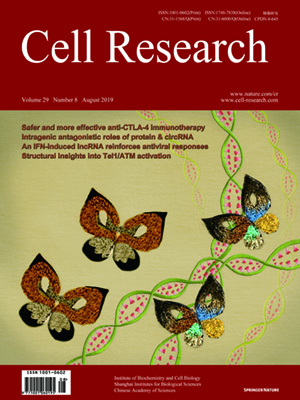
Volume 29, No 8, Aug 2019
ISSN: 1001-0602
EISSN: 1748-7838 2018
impact factor 17.848*
(Clarivate Analytics, 2019)
Volume 29 Issue 8, August 2019: 680-682
LETTERS TO THE EDITOR
Structure of the mannose transporter of the bacterial phosphotransferase system
Xueli Liu1, Jianwei Zeng1, Kai Huang1 and Jiawei Wang1
1State Key Laboratory of Membrane Biology, Beijing Advanced Innovation Center for Structural Biology, School of Life Sciences, Tsinghua University, 100084 Beijing, China
These authors contributed equally: Xueli Liu, Jianwei Zeng,Kai Huang.
Correspondence: Jiawei Wang (jwwang@tsinghua.edu.cn)
Dear Editor,
The bacterial phosphoenolpyruvate (PEP): sugar phosphotransferase system (PTS) mediates the active transport and concomitant phosphorylation of carbohydrates.1 The PTS comprises two cytoplasmic phosphoryl proteins (i.e., EI and HPr) and a species-dependent variable number of sugar-specific EII complexes (including IIA, IIB, and membrane-embedded subunits IIC/IID). EI and HPr transfer phosphoryl groups from PEP to the IIA unit. IIA and IIB sequentially transfer phosphates to sugar, which is translocated by the IIC/IID unit.2 Bacterial PTSs are classified into four evolutionarily distinct (super) families: (i) glucose/fructose/lactose (GFL) superfamily, (ii) ascorbate/galactitol (AG) superfamily, (iii) mannose–fructose–sorbose family (man-PTS), and (iv) nontransporting dihydroxyacetone family. The crystal structures of IIC transporters from GFL and AG superfamilies have been reported previously.3,4 All IIC proteins from GFL and AG superfamilies are homodimers and use an elevator mechanism to transport substrates across the cell membrane. However, the mannose family is unique in several aspects among the PTS families.1 The mannose family is the only PTS family whose members possess a IID protein, and its IIC and IID subunits have evolved in parallel and are unstable when expressed separately.2 The mannose family is also the only member among the PTS families in which the IIB constituent is phosphorylated on a histidine residue rather than a cysteine residue.3 In addition to its function in carbohydrate uptake and phosphorylation, the membrane-located components of the man-PTS complex exhibit two additional apparently unrelated activities: they play a role in the infection of Escherichia coli by bacteriophage λ for DNA penetration in the inner membrane, and they serve as target receptors for class IIa, IId, and IIe bacteriocins. Notably, class IIa and IId bacteriocins have attracted attention as potent narrow-spectrum alternatives to antibiotics or as food preservatives.5 In this study, we report the cryo-EM structure of E. coli man-PTS at resolution of 3.52 Å, which comprises ManY and ManZ, corresponding to IICMan and IIDMan components, respectively (Supplementary information, Fig. S1 and Table S1). The high quality of the ManYZ EM density allowed us to perform de novo model building for ManY and ManZ (Supplementary information, Fig. S2).6
https://doi.org/10.1038/s41422-019-0194-z
FULL TEXT | PDF
Browse 1168


